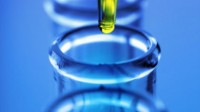Home : Custom peptide synthesis : Peptide synthesis and handling

Peptide synthesis and handling
The physico-chemical properties of peptides are heavily dependent on their amino acid sequence. Synthesis of the peptides most often proceed smoothly, and it is in the workup steps most problems with handling of the peptides are encountered. In solid phase peptide synthesis using the Fmoc-strategy, cleavage of side chain protection groups and release of the crude peptide from the synthesis resin is usually carried out in trifluoroacetic acid (TFA) with added mixtures of radical-scavengers whose optimum composition depends on the amino acid composition of the peptide.

We ship your peptides as lyophilized powders. In the dry state most purified peptides can be stored for years at -20°C without deterioration. Crude or “desalted” peptides containing cysteine, methionine or tryptophan may some cases may become modified even in the dry state. With dry peptides stored at low temperature care should be taken not to open the vial before it has reached ambient temperature. Upon request our peptides can be packed under argon to minimize oxidation during transport and/or they can be lyophilized together with a small amount of DTT. Do not store peptides for prolonged periods after dissolution in buffer. If a peptide batch is to be used many times, we advise you to order the peptide to be delivered in several lyophilized aliquots. Aliquoting of the peptides before lyophilization can be made at a modest extra cost.
Most peptides are readily soluble in near neutral buffers, but it is advisable to check the solubility of the peptide with a small aliquot at a concentration of about 1 mg/mL before attempting dissolution of the entire batch. Dissolution of the peptides is often be facilitated if pure water is added to the peptide powder before adding buffer constituents. Allow some time for the peptide to dissolve and use mild sonication or vortex mixing to see if the peptide dissolves completely. With hydrophobic peptides it may be necessary to add acetonitrile or ethanol to dissolve the peptide. If the peptide is not soluble after addition of the preferred buffer, try to increase the pH if the peptide is acidic and to lower the pH if the peptide is basic. Estimate the net charge of the peptide at near neutral pH by adding 1 for each Arg(R), Lys(K) or His(H)-residue and subtracting 1 for each Asp(D) or Glu(E) residue in the sequence. Add 1 if the peptides has a free amino group at the n-terminus and subtract 1 if the peptide has a free carboxylic acid group at the c-terminus. If the sum is positive, then the peptide is basic, and if the sum is negative then the peptide is acidic. With peptides having low solubility it may be an advantage to predissolve the peptide in a minimum volume of DMSO or in 1M acetic acid before additon of buffer constituents.
Some peptides by their nature are poorly soluble in buffers that are compatible with biological assay systems. These problem peptides often contain longer stretches of hydrophobic residues and/or regions with strong aggregation tendency. Many frustrations can be avoided if such peptides are synthesized in a modified form that is optimized for increased solubility. If we encounter peptides in your requests or orders that we judge to be poorly soluble, we will issue a warning together with suggestions as to how you can modify the peptide sequence to make it reasonably soluble. Tests to determine optimal conditions for solubilization of your individual peptides can be made upon request and the findings will be included in your spec-sheets.